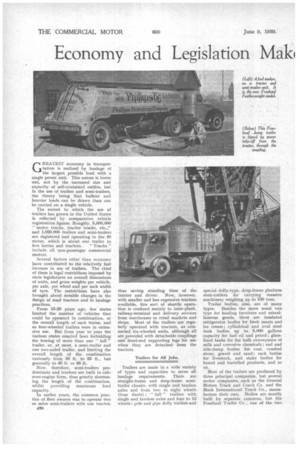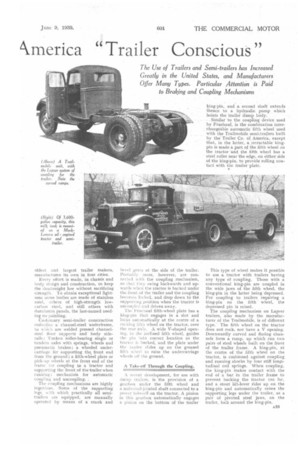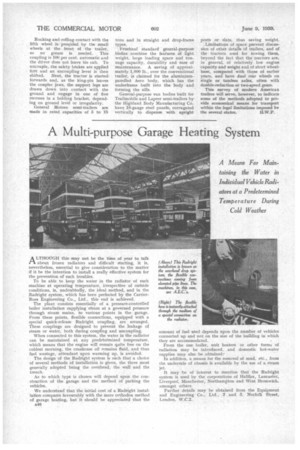Economy and Legislation Maki merica "Trailer Conscious"
Page 56

Page 57

Page 58

If you've noticed an error in this article please click here to report it so we can fix it.
The Use of Trailers and Semi-trailers has Increased Greatly in the United States, and Manufacturers Offer Many Types. Particular Attention is Paid to Braking and Coupling Mechanisms
GREATEST economy in transportation is realized by haulage of the largest possible load with a single power unit. This axiom is borne out, not by the increased size and capacity of self-contained outfits, bat in the use of trailers and semi-trailers, the theory being that bulkier and heavier loads can be drawn than can be carried on a single vehicle.
The extent to which the use of trailers has grown in the United States is reflected by comparative vehicle registration figures. Roughly, 5,000,000 " motor trucks, tractor trucks, etc.," and 1,050,000 trailers and semi-trailers are registered and operating in the 48 states, which is about one trailer to five lorries and tractors. " Trucks " include all non-passenger commercial motors.
Several factors other than economy have contributed to the relatively fast increase in use of trailers, The chief of these is legal restrictions imposed by state legislatures on overall dimensions of units, and gross weights per vehicle, per axle, per wheel and per inch width of tyre. The restrictions have also brought about notable changes in the design of road tractors and in haulage practices.
From 15-20 years ago, fewstates limited the number of vehicles that could be operated in combination, or the overall length of such trains, and so four-wheeled trailers were in extensive use. But from year to year the various states enacted laws forbidding the towing of more than one " full " trailer, or, at most, a semi-trailer and one two-axled trailer, and limiting the overall length of the combination variously from 30 ft. to 85 ft., but generally to 40 ft. or 45 ft.
Now, therefore, semi-trailers predominate and tractors are built in cabover-engine form, thus greatly shortening the length of the combination, whilst providing maximum load capacity.
In earlier years, the common practice of fleet owners was to operate two or more semi-trailers with one tractor, ES8 thus saving standing time of the tractor and driver. Now, however, with smaller and less expensive tractors available, this sort of shuttle operation is confined mainly to inter-plant, railway-terminal and delivery services from warehouses to retail markets and shops. Most of the trailers are regularly operated with tractors, as connected six-wheeled units, although all are provided with detachable couplings and front-end supporting legs for use when they are detached from the tractors.
Trailers for All Jobs.
Trailers are made in a wide variety of types and capacities to serve all haulage requirements. There are straight-frame and drop-frame semitrailer chassis,with single and tandem axles and from two to eight wheels (four duals) ; " full " trailers with single and tandem axles and four to 12 wheels; pole and pipe dolly trailers and special dolly-type, drop-frame platform semi-trailers for carrying massive machinery weighing up to 100 tons.
Trailer bodies, also, are of many types. Besides the more usual van type for hauling furniture and miscellaneous goods, there -are insulated refrigerator bodies for fresh meats and ice cream ; cylindrical and oval steel tank bodies up to 5,000 gallons capacity for fuel oil and petrol ; glasslined tanks for the bulk conveyance of milk and corrosive chemicals ; end and side-dump bodies for coal, crushed stone, gravel and sand ; rack bodies for livestock, and stake bodies for boxed and barrelled products, and so on.
Most of the trailers are produced by three principal companies, but several motor companies, such as the General Motors Truck and Coach Co. and the Mack International Truck Co., manufacture their own. Bodies are mostly built by separate concerns, but the Fruehauf Trailer Co., one of the two
oldest and largest trailer makers, manufactures its own in four cities.
Every effort is made, in chassis and body design and construction, to keep the deadweight low without sacrificing strength. To obtain exceptional lightness some bodies are made of stainless steel, others of high-strength lowcarbon steel, and still others with clurainmin panels, the last-named needing no painting.
Customary semi-trailer construction embodies a channel-steel -underframe, to WhiCIS are welded pressed channelsteel floor supports and body siderails ; Timken roller-hearing single or tandem axles with springs, wheels and pneumatic brakes; a wheeled undercarriage for supporting the, front end from the ground ; a fifth-wheel plate or pick-up wheels at the front end of the frame for coupling to a tractor and supporting the front of the trailer when running; rnechanisni for automatic coupling and uncoupling.
The coupling mechanisms are highly ingenious. Some of the supporting legs, with which practically all semitrailers are equipped, are manually operated by means of a crank and
bevel gears at the side of the trailer. Probablv more, however, are connected with the coupling mechanism, so that they swing backwards and upwards when the tractor is hacked under the front of the trailer and the coupling becomes locked, and drop down to the supporting position when the tractor is uncoupled and driven away.
The Fruehauf fifth-wheel plate has a king-pin that engages in a slot and locks automatically at the centre of a rocking fifth wheel on the tractor, over the rear axle. A wide V-shaped opening, in the inclined fifth wheel, guides rho pin into correct location as the tracnor is backed, and the plate under the trailer slides up on the greased fifth wheel to raise the undercarriage wheels off the ground.
A Take-off Through the Coupling.
A recent development, for use with dump trailers, is the provision of a gearbox under the fifth wheel and a universal-jointed .shaft connected to a power take-oil on the tractor. A pinion inn this gearbox automatically engages a pinion on the bottom of the trailer king-pin, and a second shaft extends thence to a hydraulic pump which hoists. the trailer dump body.
• Similar to the coupling device used by Fruehauf, is the combination interchangeable automatic fifth wheel used with the Trailmobile semi-trailers built by the Trailer Co. of America, except that, in the latter, a 'retractable kingpin is made a part of the fifth wheel on the tractor and the fifth wheel has a steel roller near the edge, on either side of the king-.pin, to provide rolling contact with the trailer plate.
This type of wheel makes it possible to use a tractor with trailers having any type of coupling. Those with a conventional king-pin are coupled in the wide jaws of the fifth wheel, the king-pin in the latter being depressed. For coupling to trailers requiring a king-pin on the fifth wheel, the depressed pin is raised.
The coupling mechanism on Lapeer trailers, also made by the manufacturer of the Trailmohile, is of different type.. The fifth wheel on the tractor does not rock, nor have a V opening. Downwardly curved and flaring channels form a ramp, up which run two pairs of steel wheels built on the front of the trailer frame. A king-pin, at the centre of the fifth wheel on the tractor, is cushioned against coupling and running shocks by four stiff longitudinal coil springs. When coupling, the king-pin makes contact with the end of a bar in the trailer frame to prevent hacking the tractor too far, and a stout lift-lever rides up on the king-pin and automatically raises the supporting legs under the trailer, as a pair of pivoted steel jaws, on the trailer, lock around the king-pin.
Rocking and rolling contact with the fifth wheel is provided by the small wheels at the front of the trailer, so no grease is needed. This coupling is 100 per cent, automatic and the driver does not leave his cab. To uncouple, the safety brakes are applied firSt and an uncoupling lever is then shifted. Next, the tractor is started forwards and, as the king-pin leaves the coupler jaws, the support legs are drawn down into contact with the ground and engage in one of five recesses in a holding bracket, depending on ground level or irregularity.
General Motors semi-trailers are made in rated capacities of 5 to 15 tons and in straight and drop-frame types.
Fruehauf standard general-purpose hodies combine the features of light weight, large loading space and tonnage capacity, durability and ease of maintenance. A saving of approximately 1,000 lb., over the conventional trailer, is claimed for the aluminiumpanelled Aero body, which has the underframe built into the body and forming the sills.
General-purpose van bodies built for Trailmobile and Lapeer semi-trailers by the Highland Body Manufacturing Co. have 18-gauge steel panels, corrugated vertically to dispense with upright posts or slats, thus saving weight.
Limitations of space prevent discussion of other details of trailers, and of the tractors used for towing them, beyond the fact that the tractors are, in general, of relatively low engine capacity and weight and of short wheelbase, compared with those of earlier years, and have dual rear wheels on single or tandem axles, often with double:-reduction or two-speed gears.
This survey of modern American trailers will serve, however, to indicate some of the methods adopted to provide economical means for transport within the legal limitations imposed by the several states. H.W.P.




















































































